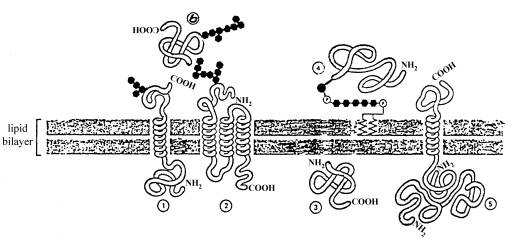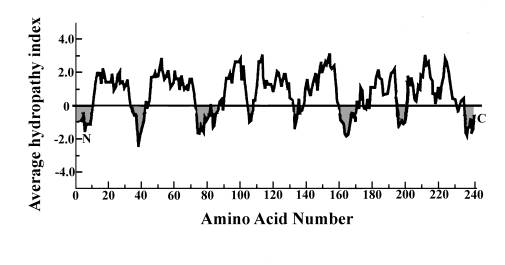2. Remember this cartoon of a biological membrane? Suppose the cartoon represented a plasma membrane, consider the ways in which the various proteins are organized in association with the membrane and answer the following questions:

A. (15 points) Compare and
contrast the likely biosynthetic pathways of proteins numbered 2, 5 and 6.
Diagrams would help!
B. (8 points) Once completely synthesized, how are proteins numbered 1 and 6 likely to be delivered accurately to their appropriate sites of function? What are the targeting mechanisms?
C. (5 pts) How would you test your hypothesis concerning either targeting mechanism?
D. (6 pts) Suppose the membrane illustrated were part of a lysosomal vesicle, how would your answers to A. and B. above differ, if at all?
2. A. Here’s a more interesting and difficult version of the same question, using data instead of a cartoon to provide useful information:
The cDNA of a gene coding for an interesting membrane protein has been cloned, amplified and sequenced, and the amino acid sequence of its probable translation product inferred from the nucleotide sequence. The protein contains 240 amino acids and exhibits an apparent molecular weight in SDS-PAGE of approximately 30 kDa. A hydropathy plot of the protein’s primary structure is presented in the figure below, numbering the amino acids from the amino terminal end to the carboxy terminal as is customary (designated "N" and "C" respectively).

A.
(4 pts) Assuming the protein is an
IMP, how many times does it span the membrane?
B.
(8 pts) How does this association with the membrane come about? Describe its synthesis.
C.
(4 pts) If the protein were to be
glycosylated during its biosynthesis, indicate with arrows which regions might
be glycosylated.
D.
( 8 pts) If the protein were to permanently reside (and function) in the ER,
how might its biosynthetic pathway differ from that taken by a plasma membrane
IMP. How might this difference in
targeting be effected? Diagrams would
help your description.
E.
(6 pts) How might you test your hypothetical targeting mechanism for this
protein? What would the results show?